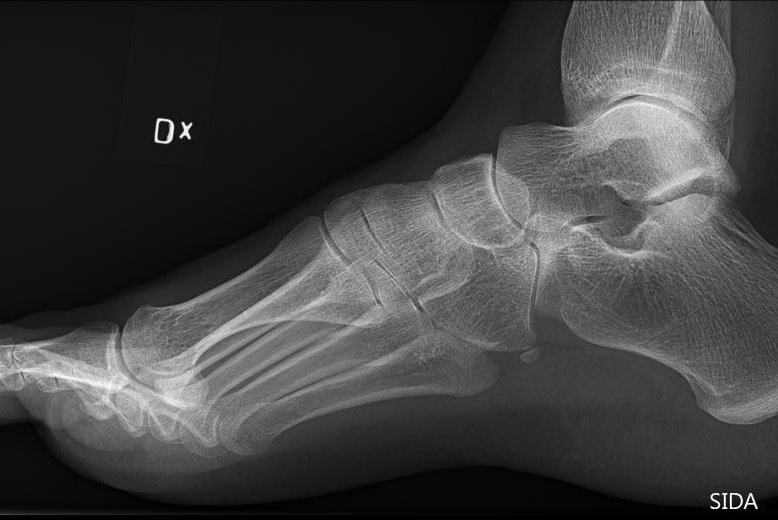
According to a new study, a long overlooked arch in the foot is key to the foot's stiffness. Photo by Mikael Häggström/Wikimedia Commons
Feb. 26 (UPI) -- The foot's longitudinal arch has long been credited with providing the stability needed for bipedalism, but new research suggests a different one, the transverse arch, is much more important.
When humans walk and run, a significant amount of pressure is placed on the foot -- a force exceeding several times the body's weight. Despite this pressure, the foot doesn't significantly bend.
This stiffness was key to the evolution of bipedalism, but scientists have long misplaced the origins of this stability. It turns out, researchers have been crediting the wrong arch.
Unlike the medial longitudinal arch, which travels the length of the foot, the transverse arch spans the width of the midfoot.
RELATED Human brain, braincase evolved independently, researchers say
"There are a set of bones with rather complicated shapes in the middle of your foot, called the tarsal bones," lead researcher Madhusudhan Venkadesan, an engineer at Yale University, told UPI in an email. "These are arranged in an arc that spans the width of the foot. The metatarsals that attach to the tarsals are therefore also arranged in an arc at one end. These bones are held together by an array of ligaments, tendons, muscles, and other fascia."
Researchers began considering the previously ignored importance of the transverse arch after pondering the stiffness of a bent dollar bill.
"Hold it with your fingers at one end of its length, and it flops down," Venkadesan said. "But press down with your thumb to slightly curl it along the width and the bill will stiffen and become straighter."
RELATED Ape-like pelvis found in Hungary could change the story of human evolution
To identify the mechanical properties at work, researchers used a combination of mathematical analysis and experiments. Their efforts, detailed Wednesday in the journal Nature, revealed the mechanical principle for why curvature induces stiffness.
"Bending a curved structure causes the material to also stretch," Venkadesan said. "Even a thin sheet of paper is quite stiff if you try to stretch it. The transverse curvature engages this stretching stiffness to stiffen the whole structure of the foot."
To test the mathematical analysis, scientists experimented with both foot mimics and cadaver feet. Because the foot's structure is so complex, they needed to test mechanical mimics of the foot first.
RELATED Scientists claim ancient supernova led humans to walk upright
Since it was impossible to remove the arch from a cadaver foot, researchers had to find a way to disable the arch's effect on stiffness. Tests using the mechanical feet showed the arch's elastic tissues are most essential to its stiffness.
"Therefore, cutting those tissues disrupts the way in which the transverse arch increases stiffness," Venkadesan said. "So, although we cannot change the arch to test the idea, we would disrupt its effect to measure its importance. The mechanical mimics allowed us to verify this experimental design."
Experiments on the feet of human cadavers proved the transverse arch and its elastic tissues are the main source of the foot's stiffness -- more important than the longitudinal arch.
RELATED Humans evolved from apes that adapted to the ground
Scientists hope their findings will inspire improved designs for robotic and prosthetic feet. The research has already offered scientists a new way to trace the evolution of bipedalism.
Analysis of the fossil record showed the transverse arch first evolved in hominins 1.5 million years before the appearance of a fully developed longitudinal arch.
"We also know that Australopithecus afarensis, the species that Lucy belonged to, left nearly human-like footprints despite not having as much of a longitudinal arch as us," Venkadesan said. "Based on these, we may speculate that animals were able to walk like us over 3.5 million years ago because of the transverse arch. The interplay with the longitudinal arch may be important for running, and more data are needed to understand these things."
No comments:
Post a Comment